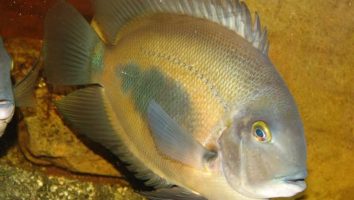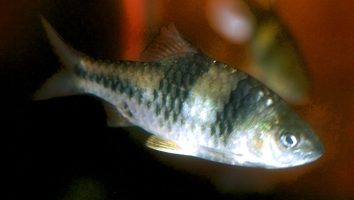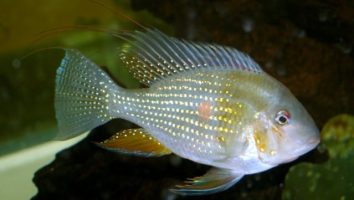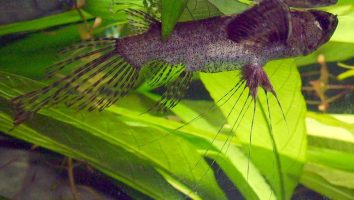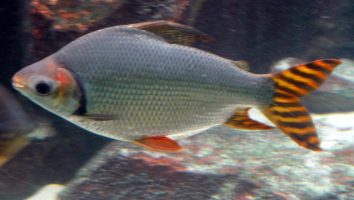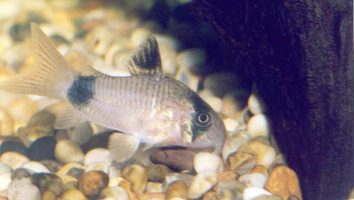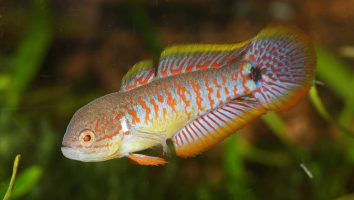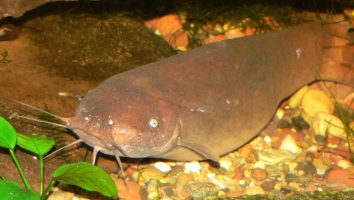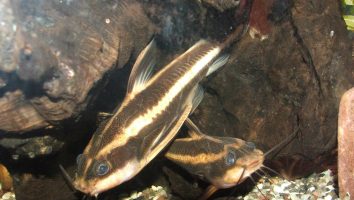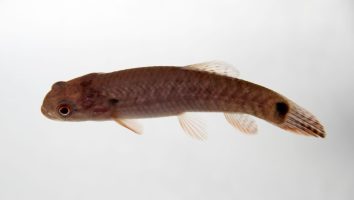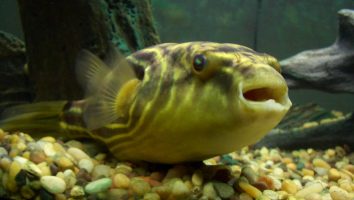The Dwarf Pencilfish (Nannostomus marginatus) is a peaceful and relatively easy to care for freshwater fish.
Despite their name, they’re not actually all that small and can grow up to 2 inches in length.
They’re a great addition to any community tank and get along well with other peaceful fish.
In this guide, we’ll teach you everything you need to know about caring for Dwarf Pencilfish. From diet and tank mates, to breeding and common problems.
Table of contents
Species overview
Dwarf pencilfish (scientific name: Nannostomus marginatus) are found throughout the Amazon basin in Peru, Brazil, and Colombia.
They prefer slow-moving waters with a lot of vegetation. This is something that’s common among many freshwater aquarium fish, as it provides a place for them to hide and feel safe.
Dwarf pencilfish are mostly herbivorous, meaning they primarily eat plants. In the wild, this includes things like algae, small insects, and other tiny invertebrates.
These fish are very peaceful and make great tank mates for other peaceful community fish. They are also very active, which can be a nice change of pace if you have a lot of slower-moving fish in your aquarium.
Appearance

The Dwarf pencilfish is a very thin and small freshwater fish. They grow to be only about 2.5 cm (1 in) in length when fully mature.
Their bodies are very long and thin, almost like a pencil, which gives them their name. Their coloration can vary depending on the exact species, but they are usually some shade of brown, gray, or green.
They have a very small and delicate dorsal fin that starts about halfway back on their body. Their anal fin is also small and located towards the back of the body.
They have a forked caudal fin that is slightly taller than the rest of their body.
Their eyes are large and protrude out from their heads quite a bit. This gives them very good eyesight which they use to find food and avoid predators.
Lifespan
The lifespan of a dwarf pencilfish in the wild is unknown. In captivity, however, they have been known to live for up to 5 years with proper care.
Size
Dwarf pencilfish only grow to be about 1.5 inches in length when fully grown, making them one of the smaller freshwater aquarium fish options.
Tank
Tank Size
A minimum tank size of 10 gallons is recommended for a single dwarf pencilfish. If you want to keep a group of them together, you should have a 20-gallon tank at the minimum.
As with most fish, it’s always best to give them a little more room than the bare minimum if you can. They are a peaceful species but can be easily outcompeted for food by larger and more aggressive fish.
Water Parameters
The dwarf pencilfish (Nannostomus marginatus) is a freshwater fish that is found in the rivers of South America. They are a peaceful community fish that does well in most aquariums.
The dwarf pencilfish is a small fish, reaching a maximum size of only 2.5 cm (1 inch). They are a dark brown color with a light stripe running down the length of their body.
The dwarf pencilfish is a peaceful fish that does well in most community aquariums. They should be kept with other small, peaceful fish. They are not suited for a tank with larger, more aggressive fish.
The dwarf pencilfish is a omnivore and will eat most aquarium foods. They should be given a varied diet that includes live, frozen, and flake foods.
The dwarf pencilfish is a hardy fish that is easy to care for. They are a good choice for beginner aquarists.
The following are some recommended water parameters for the dwarf pencilfish:
- Water temperature: 75-82 degrees Fahrenheit
- pH levels: 6.5-7.5
- Water hardness: 5-15 dGH
- Alkalinity Levels: 3-10 dKH
What To Put In Their Tank
When it comes to setting up the inside of an aquarium for Dwarf Pencilfish you can be as creative as you want. There aren’t any specific things that this species NEEDS to have, which gives you plenty of options.
We recommend some of the standard decorations that you find in a lot of freshwater tanks. There are a ton of great plants you can include (like hornwort or water wisteria). You can even throw in some floating aquarium plants too!
Rocks, driftwood, and caves are all suitable as well. It’s important to avoid going overboard with this since these fish like some room to swim.
Also, if you’re keeping your Dwarf Pencilfish in a smaller tank then it’s going to be difficult to include a lot of this stuff anyway.
A classic gravel substrate is always a good choice, but you can do with something soft and sandy if needed too (use other species you keep as a guide with this).
Common Diseases
The dwarf pencilfish is a hardy little fish that doesn’t get sick often. However, that doesn’t mean they can’t get sick at all.
The most common disease that affects this species is ich. Ich is a very common freshwater parasite that can quickly become serious if it’s not dealt with.
The most obvious symptom of ich is the presence of white spots on the body of your fish. If you see this, it’s important to act fast and begin treatment immediately.
There are other diseases that can potentially affect the dwarf pencilfish, but they’re not as common. Some of these include bacterial infections, fungal infections, and parasites.
As with most fish, the best way to keep your dwarf pencilfish healthy is to maintain a clean and stable tank. This will create an environment that is less conducive to disease and will help your fish to stay healthy.
Behavior & Temperament
The Dwarf pencilfish is a shy and retiring creature. They are not an aggressive fish, but they may nip at the fins of other, more peaceful tank mates.
This fish is also known to be a bit of a loner. They are not a schooling fish, so they will not do well in a tank with other fish that are. They prefer to have their own space and will often hide away in plants or other decorations.
Dwarf pencilfish are also known to be a bit jumpy. They are easily startled and may jump out of the water if they are spooked. It is important to have a tight-fitting lid on your tank to prevent this from happening.
Overall, the Dwarf pencilfish is a peaceful and shy fish that is best kept alone or in a tank with other peaceful fish.
Tank Mates
Because of their small size, you need to be careful when picking tank mates for dwarf pencilfish.
They’re not the most robust fish, and they can get bullied or even eaten by larger species.
Additionally, these fish come from slow-moving waters in the wild. As a result, they don’t do well in tanks with a lot of current.
With that being said, there are still plenty of compatible tank mates for dwarf pencilfish. Here are some of the best options:
- Neon Tetras
- Ghost Shrimp
- Amano Shrimp
- Guppies
- Endler’s Livebearers
- Pygmy Corydoras
- Otocinclus Catfish
- Rummy Nose Tetras
- Harlequin Rasboras
Breeding
The dwarf pencilfish is an annual spawner, which means that it only breeds once a year. The process usually takes place during the rainy season (which is why they’re also called the “rainy season fish”).
To trigger spawning, you must mimic the rainy season in their natural habitat. That means raising the water level and temperature in your tank. The water should be about 80 degrees Fahrenheit and at least 6 inches deep.
You’ll also need to add live plants to the tank. The plants provide hiding places for the fry and also help to lower the water’s pH level.
When ready, add a group of 6-8 fish to the breeding tank. It’s best to have more females than males. The ratio should be 3:1 or 4:1.
The spawning process usually happens at night. The female will lay her eggs on the underside of a leaf. After she does that, the male will fertilize them.
Once the eggs are fertilized, the adults must be removed from the tank. The fry will hatch in about 24 hours.
The fry are very small, so you must be careful when feeding them. They can only eat microscopic foods like Infusoria and baby brine shrimp.
As they grow, you can gradually increase the size of their food. After a few months, they should be big enough to eat regular-sized foods.
Conclusion
As you can see, there are many benefits to owning a Dwarf Pencilfish. They are a beautiful and unique addition to your tank, and they are very easy to care for.
The only downside is that they are not very tolerant of other fish, so you will need to be careful when choosing tank mates.
Overall, we think the Dwarf Pencilfish is a great choice for anyone looking for a new and exciting fish for their tank!

